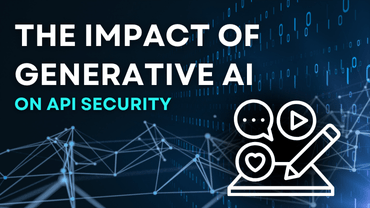The Impact of Generative AI on API Security
The advent of Generative AI has revolutionized numerous domains including cybersecurity. Generative AI is a type of artificial intelligence that can create new content, such as text, code, images, and music. It is trained on massive datasets of existing content, and then learns to generate new content that is similar to the training data.
One of the most crucial aspect cybersecurity has been impacted by Generative AI is through API Security. Application Programming Interfaces (API) is the way different application or system communicate with each other using request and responses.
How do API Work
let’s say you have a party for 10 friends and 5 extra people showed up, so you call your event planning company they route you to the customer service unit and they put you on hold but they come back and say ok they can work something immediately. That API you make a call, make a request and get a response back. If there was no customer service of the event planning company, you would have to figure put how many more drinks, chairs and small chops you would get. That’s a lot of unnecessary work on your part. In this analogy the event planning company is an application that provides a specific service, you are an application trying to entertain people, the customer service rep from the event planning company is the API which you can communicate with and make request like add more tables and chair for the guest. API assists you without diving into details how those setups are done.
The Role of Generative AI in API Security
Automating Vulnerability Testing
When testing for vulnerabilities Generative AI can simulate various attack vectors, such as SQL injection, cross-site scripting (XSS), and other common API security issues. This automated approach not only saves time but also enhances the thoroughness of the security assessment.
Enhancing Security via Threat Detection
Generative AI can detect unusual patterns that might signify credential stuffing attacks, where attackers use automated tools to try different username and password combinations. This proactive detection allows for quicker response times, reducing the potential impact of such attacks. Rather than traditional security systems often depend upon predefined rules and signatures to discover threats.
Risks and Challenges
The impact of generative AI on API security is a major concern for both enterprise and security architects. Generative AI makes it easier for attackers to find and exploit vulnerabilities in APIs, as well as to launch DoS attacks. Enterprise and security architects need to be aware of the risks posed by generative AI:
Steal API keys and credentials.
Generative AI can be used to guess or crack API keys and credentials. This can give attackers unauthorized access to APIs, which they can then use to steal data, launch attacks, or commit other malicious activities.
Data Privacy Concerns
Generative AI models require vast amounts of data to function effectively. This data often includes sensitive information, raising concerns about data privacy and protection. Ensuring that Generative AI systems adhere to privacy regulations, such as GDPR or NDPR, is crucial. Data used to train these models must be anonymized and securely stored to prevent unauthorized access.
Adversarial Attacks
One of the primary concerns is the potential for adversarial attacks. Generative AI models themselves can be targeted by attackers, who use adversarial techniques to manipulate the AI’s outputs. Feeding malicious input data, attackers can trick AI systems into misclassifying legitimate API requests as malicious or vice versa. This manipulation can lead to false positives or false negatives in threat detection, undermining the security of APIs.
Generate malicious API requests.
Generative AI can be used to generate large numbers of malicious API requests, which can overwhelm an API and cause it to crash. This is known as a denial-of-service (DoS) attack.
Dependency on AI Models
While Generative AI can enhance API security, over-reliance on it can be volatile. Generative AI aren’t infallible and might make mistakes or be bypassed with the aid of sophisticated attackers. Therefore, it’s important to keep a balanced technique, combining AI with traditional safety practices and human oversight.
Exploit API vulnerabilities.
Generative AI can be used to find and exploit vulnerabilities in APIs. For example, generative AI can be used to generate test cases that cover a wide range of possible scenarios, including some that may not have been considered by the API developers.
Best Practices for Leveraging Generative AI in API Security
To effectively harness the power of Generative AI for API security while mitigating associated risks, organizations should adopt the following best practices:
Implement strong API security controls.
This includes using authentication and authorization mechanisms, rate limiting, and input validation.
Continuous Monitoring and Updating
AI models should be constantly monitored and updated to conform to evolving threats. Regular updates ensure that the models can perceive new assault patterns and vulnerabilities.
Implementing Robust Data Security Measures
Protecting the data used to train AI models is paramount. Ensuring compliance with data safety regulations is also vital to hold trust and avoid from legal repercussions.
Combining AI with Traditional Security Measures
A layered security approach, combining AI-driven insights with conventional methods like code reviews, penetration testing, and human oversight, provides a more comprehensive defense against threats.
Educating and Training Security Teams
Security teams have to be educated and trained on capabilities and limitations of Generative AI.
Conclusion
Generative AI has the capacity to significantly effect API protection offering advanced threat detection, automated vulnerability testing, and enhanced security measures. However, it additionally introduces new challenges, inclusive of adverse assaults and facts privateness worries. By adopting excellent practices and keeping a balanced approach, organization’s can leverage Generative AI to strengthen API security whilst mitigating related risks. As AI continues to evolve, staying knowledgeable and proactive will be key to retaining strong security within the API field.




